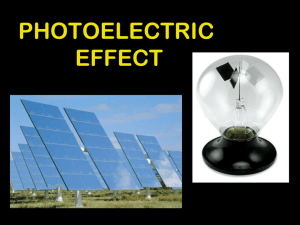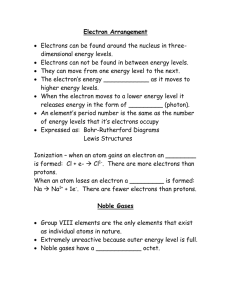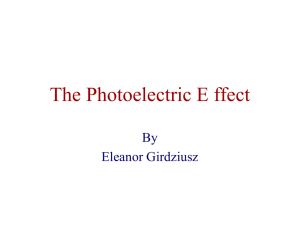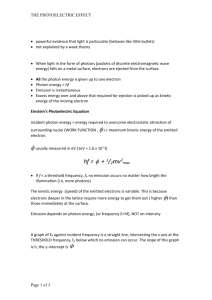Fun Electron Tricks Semiconductor Devices
advertisement
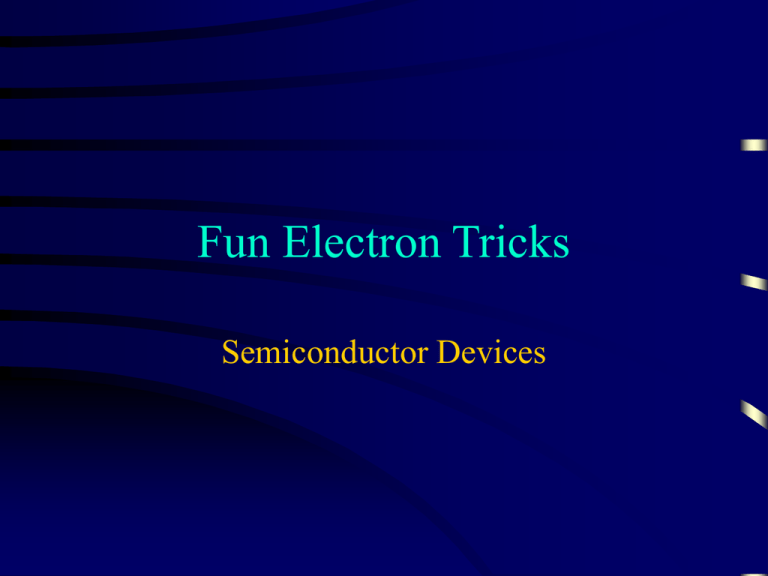
Fun Electron Tricks Semiconductor Devices npn junction • Put another n-type semiconductor on the other side of the p-type semiconductor • No matter which way I apply potential difference, one p-n junction is reverse biased, and electrons entering the p-type region quickly combine with holes, creating more negative charge MOSFET (Metal-Oxide-Semiconductor, Field-Effect Transistor) • If, however, I apply a positive potential to one side of the p-type semiconductor, without allowing another path for electrons to flow out of the device, I will create a channel for e- to get from one n-side to the other. n-type p-type n-type MOSFET • Now, if I bias the device in either direction, current will flow, electrons toward the positive potential, and conventional positive current toward the negative potential Gate n-type p-type n-type MOSFET (Metal-Oxide-Semiconductor, Field-Effect Transistor) • The potential difference between drain and source is continually applied • When the gate potential difference is applied, current flows Gate Drain Source n-type p-type n-type Bipolar Junction Transistor Emitter Base Collector increasing electron energy increasing hole energy n-type p-type n-type Bipolar Junction Transistor http://hyperphysics.phy-astr.gsu.edu/hbase/solids/trans.html#c1 How do transistors fit in? For now, view transistor as switch: If switch is “on,” current can pass If switch is “off,” no current can pass We can use this simple device to construct complicated functions NOT Gate - the simplest case Put an alternate path (output) before a switch. Output Input Switch Dump If the switch is off, the current goes through the alternate path and is output. If the switch is on, no current goes through the alternate path. So the gate output is on if the switch is off and off if the switch is on. NAND - a variation on a theme NAND gate returns a signal unless both of its two inputs are on. Put an extra switch after a NOT device Output Input Switch Input Switch Dump If both switches are on, current is dumped. Otherwise the current goes to the output. AND - slightly more complicated AND gate returns a signal only if both of its two inputs are on. Use the NAND output as input for NOT Output Switch Input Switch Input Switch Dump If both inputs are on, the NOT input is off, so the AND output is on. Else the NOT input is on, so the output is off. Interference of Waves and the Double Slit Experiment • Waves spreading out from two points, such as waves passing through two slits, will interfere l d Wave crest Wave trough Spot of constructive interference Spot of destructive interference The Double-slit experiment for particles • Particles do not diffract; they either go through a slit or they don’t • Particles passing through a slit hit a screen only in a small area; if they all have the same initial velocity, they will all hit at the exact same point • Particles passing through two slits will form two maxima in front of the two slits What Happens if Electrons Pass Through Small Openings? What does that tell you about electrons? The Plot Thickens An experiment called the “photoelectric effect” also gives unexpected results! The Photoelectric Effect, Pictorially • Light shining on a material may be absorbed by electrons in that The energy of the material If ankinetic electron absorbs electron will be to equal to the enough energy break energy absorbed by the free of its bonds, can electron minus theitenergy leave the needed to material free it, provided the electron does not lose any energy in collisions Wave theory predicts . . . • the energy of emitted electrons should depend on the intensity of light • electrons will need to soak up energy from wave for period of time before being ejected • the frequency of light won’t affect the maximum kinetic energy of electrons The Photoelectric Effect, Experimentally • As a given color (frequency) of light enters the black box-like photoelectric head, it falls on a plate of electron-emitting material inside • Emitted electrons are collected on another plate nearby, producing an electric potential difference between the two plates (like a capacitor) • When the capacitor is fully charged and no more electrons can be added, the potential energy of the capacitor equals the maximum kinetic energy of the electrons trying to leave the original plate • The potential difference on the capacitor at this point is called the stopping potential Vs for the electrons, and it is proportional to the maximum kinetic energy of electrons emitted by the light: K = eVs = Eabsorbed - F Work function (energy needed to remove electron) Do the Photoelectric Experiment Upon what does the energy of emitted electrons appear to depend? Experiment sees . . . • the energy of emitted electrons does not depend on the intensity of light • electrons are ejected immediately • the frequency of light does affect the maximum kinetic energy of electrons; kinetic energy is linearly dependent on frequency • intensity of light determines number of emitted electrons (photocurrent) Einstein to the Rescue • Einstein suggested that light was emitted or absorbed in particle-like quanta, called photons, of energy, E = hf If that energy is larger than an electron absorbs theIfwork function of the one of these photons,can it gets metal, the electron leave; if not,hf it of can’t: the entire energy. Kmax = Eabs – F = hf - F Einstein’s Photoelectric Theory eVs = Kmax = hf – F • Kmax f • Is this consistent with what you saw in the experiment? • Electrons are ejected as soon as a photon strikes the material. • Is this consistent with what you saw in the experiment? Einstein’s Photoelectric Theory eVs = Kmax = hf – F • If hf < F, no electrons are emitted; cutoff frequency • What should the slope of a K vs. f plot yield? Is that what you got? The Conflict • Wave theory accurately describes interference and diffraction, along with other behavior of light, such as dispersion and refraction • The particle theory accurately describes photoelectric effect, black body radiation, and other experimental results Is light a particle? Or is it a wave? Is a platypus a duck? Or is it a beaver? Am I my mother? Or am I my father? The Resolution • Light is not either a particle or a wave • Light exhibits wavelike properties when traveling • Light exhibits particlelike properties when interacting with matter • deBroglie suggested that traditional “particles”, like the electron, also exhibit wavelike properties • p=h/l, so large (macroscopic) momentum means small (undetectable) wavelength The interpretation • Light and “particles” propagate through space as probability waves • I cannot say for certain where a particle is, where it was, or how it got to wherever it might have been • I can, however, say where it is most likely to be found, where it most likely was, and how likely it is that it took a particular path • This behavior is described by a wave function Y(x,y) which obeys Schrödinger’s equation Before the next class, . . . • Homework 20 • Do Activity 19 Evaluation by Midnight Monday • Read Chapters 7 and 8 in Turton. • Do Reading Quiz
